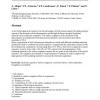Free Online Productivity Tools
i2Speak
i2Symbol
i2OCR
iTex2Img
iWeb2Print
iWeb2Shot
i2Type
iPdf2Split
iPdf2Merge
i2Bopomofo
i2Arabic
i2Style
i2Image
i2PDF
iLatex2Rtf
Sci2ools
MJ
2006
2006
Impact of the surface roughness on the electrical capacitance
A new hybrid approach consists to use the advantages of both systems namely the high geometric aspects of the electrodes of the ultracapacitor and the high dielectric strength of polymer materials used in dielectric capacitors. The surface roughness of the electrodes of the ultracapacitor is manufactured with nano-porous materials; activated carbon and carbon nanotubes (CNTs). Many compositions of both carbonaceous materials are tested with different insulating materials (liquid and solid) to constitute the hybrid capacitor. It appears that the capacitance increases with the carbonaceous composition: An increasing from 15 to 40% is observed as compared to a plane capacitor, it can be twice with a 100 wt% of CNTs content. But, the impregnation of the insulating material in the surface roughness remains the key point of the realization of the hybrid capacitor. The roughness accessibility is a major property to optimize in order to improve the impregnation of the insulating material to i...
| Added | 14 Dec 2010 |
| Updated | 14 Dec 2010 |
| Type | Journal |
| Year | 2006 |
| Where | MJ |
| Authors | A. Albina, P. L. Taberna, J. P. Cambronne, P. Simon, E. Flahaut, T. Lebey |
Comments (0)

